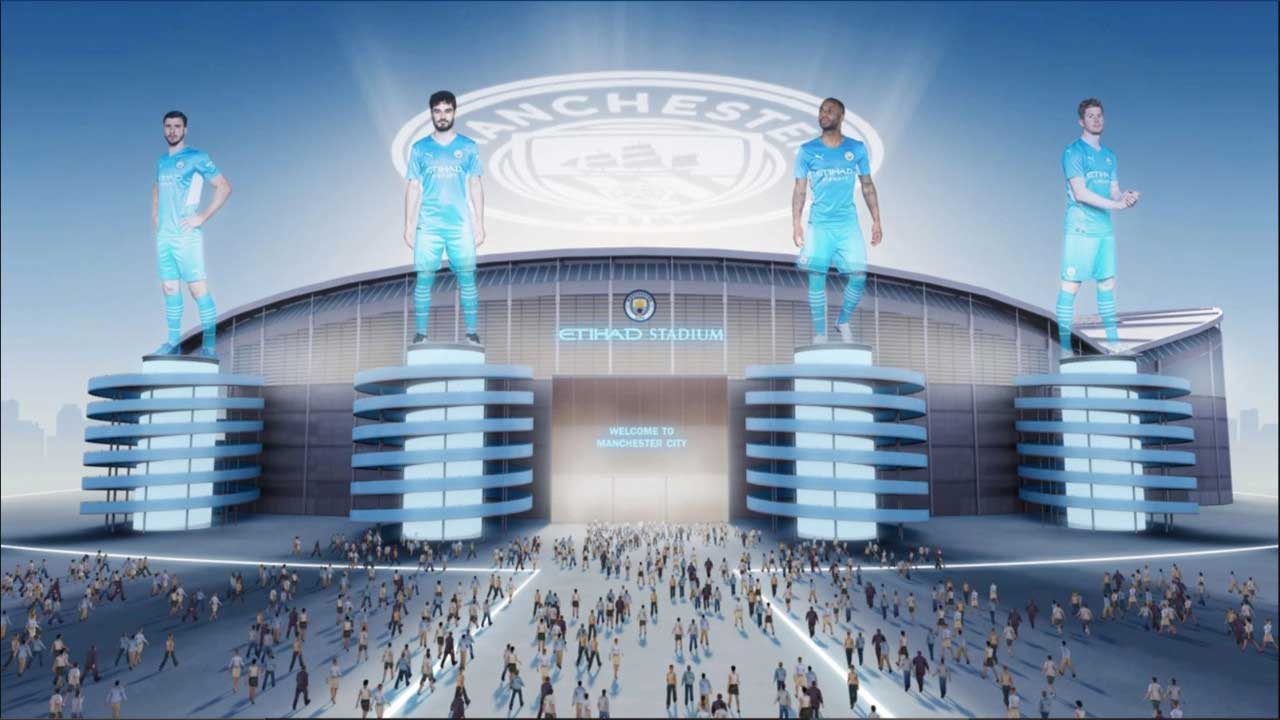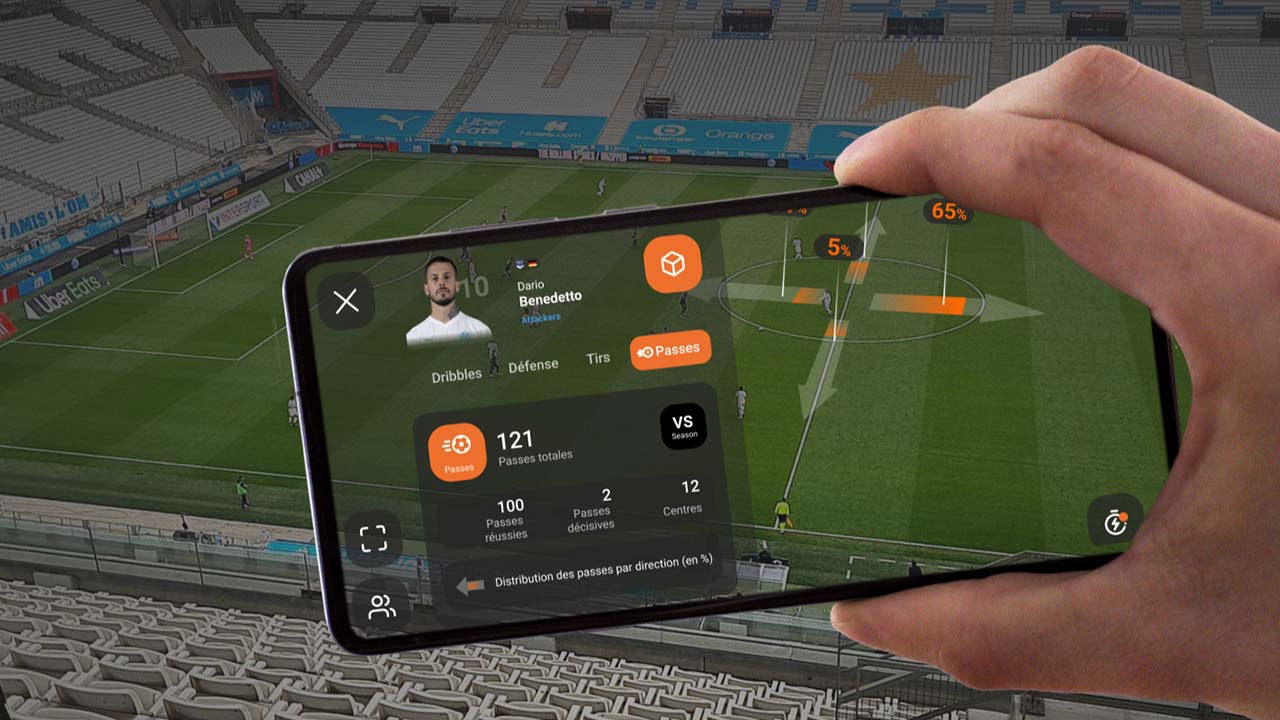Next Level Fan Experiences

This past week, DFL (Deutsche Fußball Liga) invited me to keynote at SportsInnovation 2022. With the football (soccer) pitch at Düsseldorf’s Merkur Spiel-Arena as the backdrop, rival teams played live games as various technologies were demonstrated in real time. It was awesome!
Andreas Heyden, CEO of DFL Digital Sports, said SportsInnovation 2022 was focused on how fan experiences are being enhanced “from the camera lens to the viewer’s screen.” He called it their “glass-to-glass” business model. For me, SportsInnovation 2022 was an up close personal view of the convergence of physical, online, audio, video, graphics, AR, VR, XR, MR, haptics, streaming data, and blockchain. Here’s a look at some of my favorite tech from the event.
CollectID

NFTs are smart contracts that can apply to any asset (digital or physical). As long as an item has a unique identifier (such as a contract number or a serial number), ownership can be immutably recorded as an NFT on a blockchain.
The folks at CollectID embed unique, encrypted NFC (near-field communication) chips into physical products and create NFTs that prove authenticity and ownership. Sports memorabilia and physical collectibles are the perfect use case for this group of technologies.
I was particularly fond of their work with the Nashville Predators for the release of a limited edition jersey (500 pieces) marking the retirement of Pekka Rinne’s number, but there’s so much more you can do with an NFC chip embedded in physical merchandise. It generates first-party data, it can be used as an automatic loyalty card or a ticket to an event, and it can grant access to VIP areas or experiences at the arena or elsewhere. The uses for this technology are only limited by your imagination. This tech (or something very much like it) will be the paradigm shift in the bridge between our physical and “meta” worlds.
Hawk-Eye, a subsidiary of Sony

Tennis fans already know about Hawk-Eye tech and line judges. The company is also known for its exceptional work in skeletal tracking. I was excited to learn more about the work they are doing in Web3 and the metaverse.
I was fascinated by the way Hawk-Eye combines data from a vast array of inputs to create virtual representations of our physical world. One great example is the work they are doing with Manchester City to digitally recreate Etihad Stadium.
The tech goes way deeper than that, and there are many potential use cases for this bridge between the physical and virtual worlds. What will it be like to experience a game recreated in real time in the metaverse? (In this case, I mean cartoon characters in a cartoon universe.) The translation of streaming data into animation (stylized or photo-realistic) is a new frontier for storytellers and audiences alike. Add in the potential of engage-to-earn business models and it’s hard to step away from the whiteboard.
Immersiv – ARISE

I’ve never been a believer in “clicking on Jennifer Aniston’s sweater,” but there’s something about being able to click on a live player in an arena in real-time that I love. Am I too lazy to search Google for the player’s name or number? Yes. Will I occasionally use voice search at a game? Yes. Is it way more fun to hold up your phone and simply click on the player? Yes. Yes. Yes. Plus, you get all kinds of real-time stats and info you can’t get when you simply search online.
ARISE is showing a clear path to the future of live engagement. In truth, I’d love this tech for movies and streaming videos. (Streamers, are you paying attention?) Why am I still being forced to open IMDb and search for an actor or director or movie? I digress.
When Moritz M. Mücke, Head of Digital Innovations at DFL, did a demonstration of this technology with a live game on the field behind him, it was clear that we are on the cusp of the next level of live fan experiences and engagement.
Reality Check

In-stadium, live experiences call for a tremendous amount of infrastructure. My old friend, Skarpi Hedinsson (CTO of the Los Angeles Rams) did an awe-inspiring talk that included a description of the network topology of SoFi stadium. Its 1,400+ wireless cells empower fans to enjoy any kind of real-time online experience while at the venue.
Imagine how much infrastructure it takes to give 70,000-100,000 people high-bandwidth, low-latency access to the internet from inside an edifice made of steel and reinforced concrete. Construction costs for SoFi are estimated to have been between $5-6 billion. Looking at the remarkable capabilities of the stadium, the tech budget must have been remarkable as well.
What’s Next?
What I love about well-run tech conferences is that they give you a couple of different lenses with which you can view the future. You can see the wonder of the tech and its potential applications. You can imagine how the tech might modify or change consumer behaviors. You can think about the business requirements and implications. SportsInnovation 2022 was a well-run tech conference. Congratulations to the DFL (and SpielMacher) for putting on a truly inspiring show.
Disclosure: This is not a sponsored post. I am the author of this article and it expresses my own opinions. I am not, nor is my company, receiving compensation for it. I am not a financial ...
more


